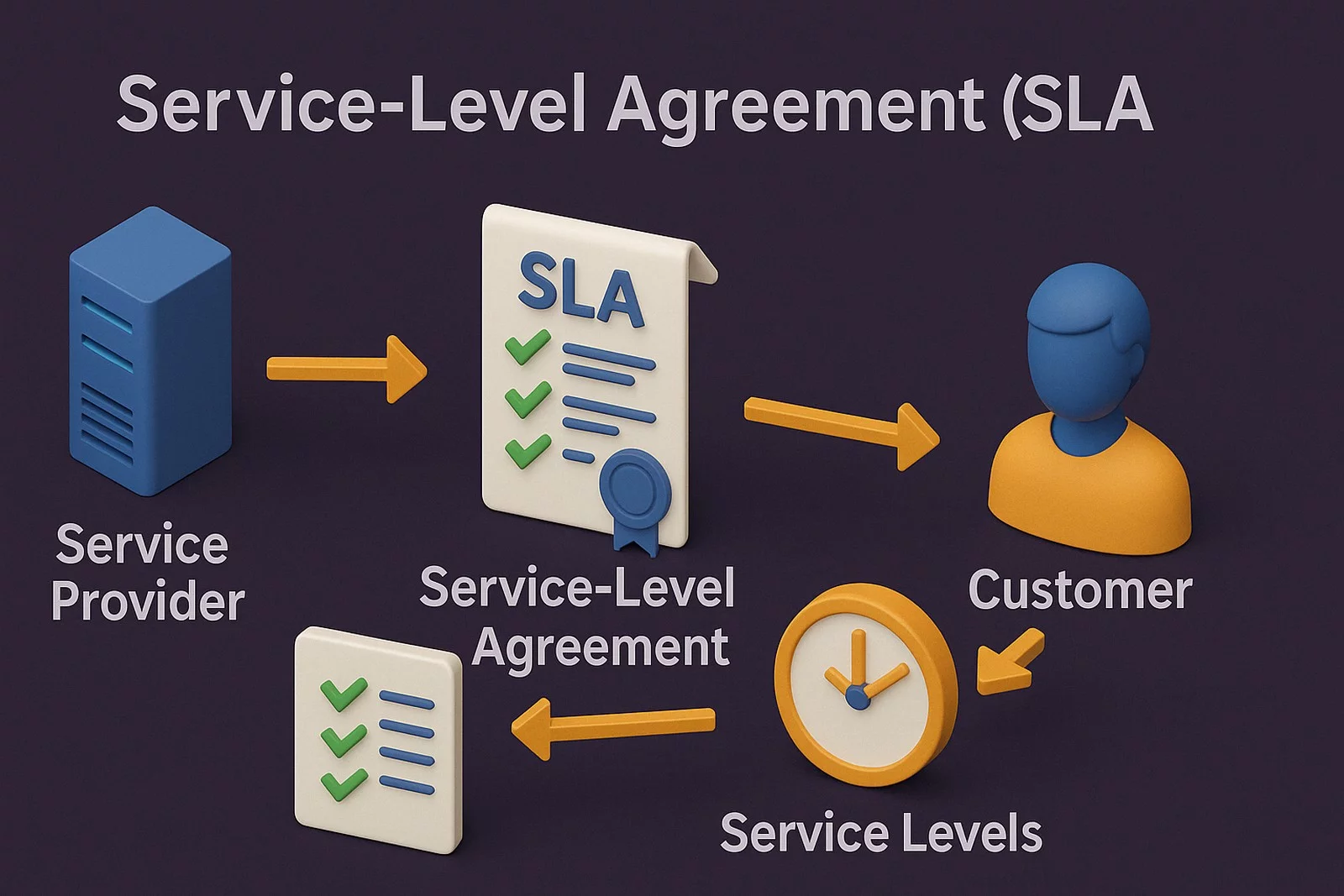Service-Level Agreements (SLA)

Quick Navigation:
- Service-Level Agreements (SLA) Definition
- Service-Level Agreements (SLA) Explained Easy
- Service-Level Agreements (SLA) Origin
- Service-Level Agreements (SLA) Etymology
- Service-Level Agreements (SLA) Usage Trends
- Service-Level Agreements (SLA) Usage
- Service-Level Agreements (SLA) Examples in Context
- Service-Level Agreements (SLA) FAQ
- Service-Level Agreements (SLA) Related Words
Service-Level Agreements (SLA) Definition
A Service-Level Agreement (SLA) is a formal contract between a service provider and a customer that defines the level of service expected. It outlines key metrics like uptime, response time, issue resolution deadlines, and responsibilities of both parties. SLAs are common in IT services, cloud computing, telecommunications, and customer support. They serve as benchmarks to measure performance and often include penalties or remedies if obligations are not met. The SLA ensures transparency, accountability, and clear expectations between provider and consumer.
Service-Level Agreements (SLA) Explained Easy
Imagine you ask someone to deliver pizza within 30 minutes. If they agree and promise to stick to that timing, that’s like an SLA. It’s an agreement on what will happen and how long it will take. If they are late, they might give you a free pizza. In big companies, SLAs help ensure services like websites or apps are always working, and if something breaks, it gets fixed quickly.
Service-Level Agreements (SLA) Origin
SLAs originated from the need for formal accountability in service delivery. The concept became prominent in the 1980s with the growth of outsourcing and IT services. As businesses increasingly relied on external vendors, clear contractual terms defining performance standards became necessary.
Service-Level Agreements (SLA) Etymology
The term comes from contractual language where "service level" refers to the agreed standard of performance, and "agreement" signifies the binding contract between two parties.
Service-Level Agreements (SLA) Usage Trends
Over the last two decades, SLAs have evolved beyond IT to include cloud services, managed services, cybersecurity, and even HR outsourcing. The increasing dependency on digital services has led to stricter, more comprehensive SLAs with detailed reporting and penalty clauses. With the rise of AI and automation, dynamic SLAs that adapt to real-time conditions are also emerging.
Service-Level Agreements (SLA) Usage
- Formal/Technical Tagging:
- IT Contracts
- Cloud Services
- Managed Services
- Performance Benchmarks - Typical Collocations:
- "uptime SLA"
- "response time SLA"
- "SLA breach"
- "SLA compliance"
Service-Level Agreements (SLA) Examples in Context
- A cloud provider guarantees 99.9% uptime as part of its SLA with clients.
- An IT helpdesk promises to respond to critical issues within one hour per its SLA.
- Telecom companies define connection speeds and downtime allowances in their SLAs.
Service-Level Agreements (SLA) FAQ
- What is a Service-Level Agreement (SLA)?
An SLA is a contract defining service expectations, metrics, and penalties between a provider and a customer. - Why are SLAs important?
They ensure accountability, transparency, and clear performance standards. - What are common components of an SLA?
Uptime guarantees, response time commitments, resolution deadlines, and escalation procedures. - Can SLAs be changed?
Yes, they can be renegotiated if business needs change or both parties agree. - What happens if an SLA is breached?
Penalties, financial compensation, or service credits may be applied. - Are SLAs only for IT services?
No, they are also used in telecommunications, cloud computing, managed services, and even HR. - How are SLAs measured?
Through key performance indicators (KPIs) and regular monitoring reports. - Do small businesses use SLAs?
Yes, especially when dealing with service providers like hosting companies or managed IT providers. - Can SLAs be automated?
Yes, monitoring and reporting are often automated to ensure compliance. - What’s the future of SLAs?
Dynamic SLAs adapting in real-time based on AI monitoring are becoming more common.

Service-Level Agreements (SLA) Related Words
- Categories/Topics:
- IT Management
- Service Quality
- Cloud Computing
- Outsourcing
- Vendor Management
Did you know?
In 2013, Amazon’s AWS faced a major outage, and due to SLA commitments, they had to issue millions in service credits to clients. This incident reinforced how vital SLAs are in holding providers accountable and protecting customers.
Authors | Arjun Vishnu | @ArjunAndVishnu

PicDictionary.com is an online dictionary in pictures. If you have questions or suggestions, please reach out to us on WhatsApp or Twitter.
I am Vishnu. I like AI, Linux, Single Board Computers, and Cloud Computing. I create the web & video content, and I also write for popular websites.
My younger brother, Arjun handles image & video editing. Together, we run a YouTube Channel that's focused on reviewing gadgets and explaining technology.
















Comments (0)
Comments powered by CComment